Stuttgart–Hattingen railway
The Stuttgart–Hattingen railway, also known as the Gäu Railway[2] (German: Gäubahn, IPA: [ˈɡɔɪbaːn]) is a 148.5-kilometer-long railway in the southern part of the state of Baden-Württemberg in Germany, running from Stuttgart to Hattingen. The Royal Württemberg State Railways (Königlich Württembergischen Staats-Eisenbahnen or K.W.St.E.) and the Baden State Railways (Badische Staatseisenbahnen) constructed the majority of this line between the years 1866 and 1879. However, the line in its present form was not completed until the Deutsche Reichsbahn finished construction on the connection between Tuttlingen and Hattingen in 1934. Today the partially single-track, fully electrified line features the high-speed Intercity-Express (ICE) service, with its tilting train technology, traveling from Stuttgart to Zurich. In addition, a multitude of local train services of numerous railway companies are on offer. The Gäu Railway is also a significant line in the North-South freight service system.
| Stuttgart–Hattingen railway | |||||||||||||||||||||||||||||||||||||||||||||||||||||||||||||||||||||||||||||||||||||||||||||||||||||||||||||||||||||||||||||||||||||||||||||||||||||||||||||||||||||||||||||||||||||||||||||||||||||||||||||||||||||||||||||||||||||||||||||||||||||||||||||||||||||||||||||||||||||||||||||||||||||||||||||||||||||||||||||||||||||||||||||||||||||||||||||||||||||||||||||||||||||||||||||||||||||||||||||||||||||||||||||||||||||||||||||||||||||||||||||||||||||||||||||||||||||||||||||||||||||||||||||||||||||||||||||||||||||||||||||||||||||||||||||||||||||||||||||||||||||||||||||||||||||||||||||||||||||||||||||||||||||||||||||||||||||||||||||||||||||||||||||||||||||||||||||||||||||||||||||||||||||||||||||||||||||||||||||||||||||||||||||||||||||||||||||||||||||||||||||||||||||||||||||||||||||||||
|---|---|---|---|---|---|---|---|---|---|---|---|---|---|---|---|---|---|---|---|---|---|---|---|---|---|---|---|---|---|---|---|---|---|---|---|---|---|---|---|---|---|---|---|---|---|---|---|---|---|---|---|---|---|---|---|---|---|---|---|---|---|---|---|---|---|---|---|---|---|---|---|---|---|---|---|---|---|---|---|---|---|---|---|---|---|---|---|---|---|---|---|---|---|---|---|---|---|---|---|---|---|---|---|---|---|---|---|---|---|---|---|---|---|---|---|---|---|---|---|---|---|---|---|---|---|---|---|---|---|---|---|---|---|---|---|---|---|---|---|---|---|---|---|---|---|---|---|---|---|---|---|---|---|---|---|---|---|---|---|---|---|---|---|---|---|---|---|---|---|---|---|---|---|---|---|---|---|---|---|---|---|---|---|---|---|---|---|---|---|---|---|---|---|---|---|---|---|---|---|---|---|---|---|---|---|---|---|---|---|---|---|---|---|---|---|---|---|---|---|---|---|---|---|---|---|---|---|---|---|---|---|---|---|---|---|---|---|---|---|---|---|---|---|---|---|---|---|---|---|---|---|---|---|---|---|---|---|---|---|---|---|---|---|---|---|---|---|---|---|---|---|---|---|---|---|---|---|---|---|---|---|---|---|---|---|---|---|---|---|---|---|---|---|---|---|---|---|---|---|---|---|---|---|---|---|---|---|---|---|---|---|---|---|---|---|---|---|---|---|---|---|---|---|---|---|---|---|---|---|---|---|---|---|---|---|---|---|---|---|---|---|---|---|---|---|---|---|---|---|---|---|---|---|---|---|---|---|---|---|---|---|---|---|---|---|---|---|---|---|---|---|---|---|---|---|---|---|---|---|---|---|---|---|---|---|---|---|---|---|---|---|---|---|---|---|---|---|---|---|---|---|---|---|---|---|---|---|---|---|---|---|---|---|---|---|---|---|---|---|---|---|---|---|---|---|---|---|---|---|---|---|---|---|---|---|---|---|---|---|---|---|---|---|---|---|---|---|---|---|---|---|---|---|---|---|---|---|---|---|---|---|---|---|---|---|---|---|---|---|---|---|---|---|---|---|---|---|---|---|---|---|---|---|---|---|---|---|---|---|---|---|---|---|---|---|---|---|---|---|---|---|---|---|---|---|---|---|---|---|---|---|---|---|---|---|---|---|---|---|---|---|---|---|---|---|---|---|---|---|---|---|---|---|---|---|---|---|---|---|---|---|---|---|---|---|---|---|---|---|---|---|---|---|---|---|---|---|---|---|---|---|---|---|---|---|---|---|---|---|---|---|---|---|---|---|---|---|---|---|---|---|---|---|---|---|---|---|---|---|---|---|---|---|---|---|---|---|---|---|---|---|---|---|---|---|---|---|---|---|---|---|---|---|---|---|---|---|---|---|---|---|---|---|---|---|---|---|---|---|---|---|---|---|---|---|---|---|---|---|---|---|---|---|---|---|---|---|---|---|---|---|---|---|---|---|---|---|---|---|---|---|---|---|---|---|---|---|---|---|---|---|---|---|---|---|---|---|---|---|---|---|---|---|---|---|---|---|---|---|---|---|---|---|---|---|---|---|---|---|---|---|---|---|---|---|---|---|---|---|---|---|---|---|---|---|---|---|---|---|---|---|---|---|---|---|---|---|---|---|---|---|---|---|---|---|---|---|---|---|---|---|---|---|---|---|---|---|---|---|---|---|---|---|---|---|---|---|---|---|---|---|---|---|---|---|---|---|---|---|---|---|---|---|---|---|---|---|---|---|---|---|---|---|---|---|---|---|---|---|---|---|---|---|
.png) | |||||||||||||||||||||||||||||||||||||||||||||||||||||||||||||||||||||||||||||||||||||||||||||||||||||||||||||||||||||||||||||||||||||||||||||||||||||||||||||||||||||||||||||||||||||||||||||||||||||||||||||||||||||||||||||||||||||||||||||||||||||||||||||||||||||||||||||||||||||||||||||||||||||||||||||||||||||||||||||||||||||||||||||||||||||||||||||||||||||||||||||||||||||||||||||||||||||||||||||||||||||||||||||||||||||||||||||||||||||||||||||||||||||||||||||||||||||||||||||||||||||||||||||||||||||||||||||||||||||||||||||||||||||||||||||||||||||||||||||||||||||||||||||||||||||||||||||||||||||||||||||||||||||||||||||||||||||||||||||||||||||||||||||||||||||||||||||||||||||||||||||||||||||||||||||||||||||||||||||||||||||||||||||||||||||||||||||||||||||||||||||||||||||||||||||||||||||||||
| Overview | |||||||||||||||||||||||||||||||||||||||||||||||||||||||||||||||||||||||||||||||||||||||||||||||||||||||||||||||||||||||||||||||||||||||||||||||||||||||||||||||||||||||||||||||||||||||||||||||||||||||||||||||||||||||||||||||||||||||||||||||||||||||||||||||||||||||||||||||||||||||||||||||||||||||||||||||||||||||||||||||||||||||||||||||||||||||||||||||||||||||||||||||||||||||||||||||||||||||||||||||||||||||||||||||||||||||||||||||||||||||||||||||||||||||||||||||||||||||||||||||||||||||||||||||||||||||||||||||||||||||||||||||||||||||||||||||||||||||||||||||||||||||||||||||||||||||||||||||||||||||||||||||||||||||||||||||||||||||||||||||||||||||||||||||||||||||||||||||||||||||||||||||||||||||||||||||||||||||||||||||||||||||||||||||||||||||||||||||||||||||||||||||||||||||||||||||||||||||||
| Other name(s) | Gäu Railway | ||||||||||||||||||||||||||||||||||||||||||||||||||||||||||||||||||||||||||||||||||||||||||||||||||||||||||||||||||||||||||||||||||||||||||||||||||||||||||||||||||||||||||||||||||||||||||||||||||||||||||||||||||||||||||||||||||||||||||||||||||||||||||||||||||||||||||||||||||||||||||||||||||||||||||||||||||||||||||||||||||||||||||||||||||||||||||||||||||||||||||||||||||||||||||||||||||||||||||||||||||||||||||||||||||||||||||||||||||||||||||||||||||||||||||||||||||||||||||||||||||||||||||||||||||||||||||||||||||||||||||||||||||||||||||||||||||||||||||||||||||||||||||||||||||||||||||||||||||||||||||||||||||||||||||||||||||||||||||||||||||||||||||||||||||||||||||||||||||||||||||||||||||||||||||||||||||||||||||||||||||||||||||||||||||||||||||||||||||||||||||||||||||||||||||||||||||||||||
| Native name | Gäubahn | ||||||||||||||||||||||||||||||||||||||||||||||||||||||||||||||||||||||||||||||||||||||||||||||||||||||||||||||||||||||||||||||||||||||||||||||||||||||||||||||||||||||||||||||||||||||||||||||||||||||||||||||||||||||||||||||||||||||||||||||||||||||||||||||||||||||||||||||||||||||||||||||||||||||||||||||||||||||||||||||||||||||||||||||||||||||||||||||||||||||||||||||||||||||||||||||||||||||||||||||||||||||||||||||||||||||||||||||||||||||||||||||||||||||||||||||||||||||||||||||||||||||||||||||||||||||||||||||||||||||||||||||||||||||||||||||||||||||||||||||||||||||||||||||||||||||||||||||||||||||||||||||||||||||||||||||||||||||||||||||||||||||||||||||||||||||||||||||||||||||||||||||||||||||||||||||||||||||||||||||||||||||||||||||||||||||||||||||||||||||||||||||||||||||||||||||||||||||||
| Locale | Baden-Württemberg, Germany | ||||||||||||||||||||||||||||||||||||||||||||||||||||||||||||||||||||||||||||||||||||||||||||||||||||||||||||||||||||||||||||||||||||||||||||||||||||||||||||||||||||||||||||||||||||||||||||||||||||||||||||||||||||||||||||||||||||||||||||||||||||||||||||||||||||||||||||||||||||||||||||||||||||||||||||||||||||||||||||||||||||||||||||||||||||||||||||||||||||||||||||||||||||||||||||||||||||||||||||||||||||||||||||||||||||||||||||||||||||||||||||||||||||||||||||||||||||||||||||||||||||||||||||||||||||||||||||||||||||||||||||||||||||||||||||||||||||||||||||||||||||||||||||||||||||||||||||||||||||||||||||||||||||||||||||||||||||||||||||||||||||||||||||||||||||||||||||||||||||||||||||||||||||||||||||||||||||||||||||||||||||||||||||||||||||||||||||||||||||||||||||||||||||||||||||||||||||||||
| Termini | Stuttgart Hattingen (Baden) | ||||||||||||||||||||||||||||||||||||||||||||||||||||||||||||||||||||||||||||||||||||||||||||||||||||||||||||||||||||||||||||||||||||||||||||||||||||||||||||||||||||||||||||||||||||||||||||||||||||||||||||||||||||||||||||||||||||||||||||||||||||||||||||||||||||||||||||||||||||||||||||||||||||||||||||||||||||||||||||||||||||||||||||||||||||||||||||||||||||||||||||||||||||||||||||||||||||||||||||||||||||||||||||||||||||||||||||||||||||||||||||||||||||||||||||||||||||||||||||||||||||||||||||||||||||||||||||||||||||||||||||||||||||||||||||||||||||||||||||||||||||||||||||||||||||||||||||||||||||||||||||||||||||||||||||||||||||||||||||||||||||||||||||||||||||||||||||||||||||||||||||||||||||||||||||||||||||||||||||||||||||||||||||||||||||||||||||||||||||||||||||||||||||||||||||||||||||||||
| Line number |
| ||||||||||||||||||||||||||||||||||||||||||||||||||||||||||||||||||||||||||||||||||||||||||||||||||||||||||||||||||||||||||||||||||||||||||||||||||||||||||||||||||||||||||||||||||||||||||||||||||||||||||||||||||||||||||||||||||||||||||||||||||||||||||||||||||||||||||||||||||||||||||||||||||||||||||||||||||||||||||||||||||||||||||||||||||||||||||||||||||||||||||||||||||||||||||||||||||||||||||||||||||||||||||||||||||||||||||||||||||||||||||||||||||||||||||||||||||||||||||||||||||||||||||||||||||||||||||||||||||||||||||||||||||||||||||||||||||||||||||||||||||||||||||||||||||||||||||||||||||||||||||||||||||||||||||||||||||||||||||||||||||||||||||||||||||||||||||||||||||||||||||||||||||||||||||||||||||||||||||||||||||||||||||||||||||||||||||||||||||||||||||||||||||||||||||||||||||||||||
| Operation | |||||||||||||||||||||||||||||||||||||||||||||||||||||||||||||||||||||||||||||||||||||||||||||||||||||||||||||||||||||||||||||||||||||||||||||||||||||||||||||||||||||||||||||||||||||||||||||||||||||||||||||||||||||||||||||||||||||||||||||||||||||||||||||||||||||||||||||||||||||||||||||||||||||||||||||||||||||||||||||||||||||||||||||||||||||||||||||||||||||||||||||||||||||||||||||||||||||||||||||||||||||||||||||||||||||||||||||||||||||||||||||||||||||||||||||||||||||||||||||||||||||||||||||||||||||||||||||||||||||||||||||||||||||||||||||||||||||||||||||||||||||||||||||||||||||||||||||||||||||||||||||||||||||||||||||||||||||||||||||||||||||||||||||||||||||||||||||||||||||||||||||||||||||||||||||||||||||||||||||||||||||||||||||||||||||||||||||||||||||||||||||||||||||||||||||||||||||||||
| Owner | Deutsche Bahn | ||||||||||||||||||||||||||||||||||||||||||||||||||||||||||||||||||||||||||||||||||||||||||||||||||||||||||||||||||||||||||||||||||||||||||||||||||||||||||||||||||||||||||||||||||||||||||||||||||||||||||||||||||||||||||||||||||||||||||||||||||||||||||||||||||||||||||||||||||||||||||||||||||||||||||||||||||||||||||||||||||||||||||||||||||||||||||||||||||||||||||||||||||||||||||||||||||||||||||||||||||||||||||||||||||||||||||||||||||||||||||||||||||||||||||||||||||||||||||||||||||||||||||||||||||||||||||||||||||||||||||||||||||||||||||||||||||||||||||||||||||||||||||||||||||||||||||||||||||||||||||||||||||||||||||||||||||||||||||||||||||||||||||||||||||||||||||||||||||||||||||||||||||||||||||||||||||||||||||||||||||||||||||||||||||||||||||||||||||||||||||||||||||||||||||||||||||||||||
| Operator(s) | DB Netz | ||||||||||||||||||||||||||||||||||||||||||||||||||||||||||||||||||||||||||||||||||||||||||||||||||||||||||||||||||||||||||||||||||||||||||||||||||||||||||||||||||||||||||||||||||||||||||||||||||||||||||||||||||||||||||||||||||||||||||||||||||||||||||||||||||||||||||||||||||||||||||||||||||||||||||||||||||||||||||||||||||||||||||||||||||||||||||||||||||||||||||||||||||||||||||||||||||||||||||||||||||||||||||||||||||||||||||||||||||||||||||||||||||||||||||||||||||||||||||||||||||||||||||||||||||||||||||||||||||||||||||||||||||||||||||||||||||||||||||||||||||||||||||||||||||||||||||||||||||||||||||||||||||||||||||||||||||||||||||||||||||||||||||||||||||||||||||||||||||||||||||||||||||||||||||||||||||||||||||||||||||||||||||||||||||||||||||||||||||||||||||||||||||||||||||||||||||||||||
| Technical | |||||||||||||||||||||||||||||||||||||||||||||||||||||||||||||||||||||||||||||||||||||||||||||||||||||||||||||||||||||||||||||||||||||||||||||||||||||||||||||||||||||||||||||||||||||||||||||||||||||||||||||||||||||||||||||||||||||||||||||||||||||||||||||||||||||||||||||||||||||||||||||||||||||||||||||||||||||||||||||||||||||||||||||||||||||||||||||||||||||||||||||||||||||||||||||||||||||||||||||||||||||||||||||||||||||||||||||||||||||||||||||||||||||||||||||||||||||||||||||||||||||||||||||||||||||||||||||||||||||||||||||||||||||||||||||||||||||||||||||||||||||||||||||||||||||||||||||||||||||||||||||||||||||||||||||||||||||||||||||||||||||||||||||||||||||||||||||||||||||||||||||||||||||||||||||||||||||||||||||||||||||||||||||||||||||||||||||||||||||||||||||||||||||||||||||||||||||||||
| Line length | 148.5 km (92.3 mi) | ||||||||||||||||||||||||||||||||||||||||||||||||||||||||||||||||||||||||||||||||||||||||||||||||||||||||||||||||||||||||||||||||||||||||||||||||||||||||||||||||||||||||||||||||||||||||||||||||||||||||||||||||||||||||||||||||||||||||||||||||||||||||||||||||||||||||||||||||||||||||||||||||||||||||||||||||||||||||||||||||||||||||||||||||||||||||||||||||||||||||||||||||||||||||||||||||||||||||||||||||||||||||||||||||||||||||||||||||||||||||||||||||||||||||||||||||||||||||||||||||||||||||||||||||||||||||||||||||||||||||||||||||||||||||||||||||||||||||||||||||||||||||||||||||||||||||||||||||||||||||||||||||||||||||||||||||||||||||||||||||||||||||||||||||||||||||||||||||||||||||||||||||||||||||||||||||||||||||||||||||||||||||||||||||||||||||||||||||||||||||||||||||||||||||||||||||||||||||
| Track gauge | 1,435 mm (4 ft 8 1⁄2 in) standard gauge | ||||||||||||||||||||||||||||||||||||||||||||||||||||||||||||||||||||||||||||||||||||||||||||||||||||||||||||||||||||||||||||||||||||||||||||||||||||||||||||||||||||||||||||||||||||||||||||||||||||||||||||||||||||||||||||||||||||||||||||||||||||||||||||||||||||||||||||||||||||||||||||||||||||||||||||||||||||||||||||||||||||||||||||||||||||||||||||||||||||||||||||||||||||||||||||||||||||||||||||||||||||||||||||||||||||||||||||||||||||||||||||||||||||||||||||||||||||||||||||||||||||||||||||||||||||||||||||||||||||||||||||||||||||||||||||||||||||||||||||||||||||||||||||||||||||||||||||||||||||||||||||||||||||||||||||||||||||||||||||||||||||||||||||||||||||||||||||||||||||||||||||||||||||||||||||||||||||||||||||||||||||||||||||||||||||||||||||||||||||||||||||||||||||||||||||||||||||||||
| Electrification | 15 kV/16.7 Hz AC overhead catenary | ||||||||||||||||||||||||||||||||||||||||||||||||||||||||||||||||||||||||||||||||||||||||||||||||||||||||||||||||||||||||||||||||||||||||||||||||||||||||||||||||||||||||||||||||||||||||||||||||||||||||||||||||||||||||||||||||||||||||||||||||||||||||||||||||||||||||||||||||||||||||||||||||||||||||||||||||||||||||||||||||||||||||||||||||||||||||||||||||||||||||||||||||||||||||||||||||||||||||||||||||||||||||||||||||||||||||||||||||||||||||||||||||||||||||||||||||||||||||||||||||||||||||||||||||||||||||||||||||||||||||||||||||||||||||||||||||||||||||||||||||||||||||||||||||||||||||||||||||||||||||||||||||||||||||||||||||||||||||||||||||||||||||||||||||||||||||||||||||||||||||||||||||||||||||||||||||||||||||||||||||||||||||||||||||||||||||||||||||||||||||||||||||||||||||||||||||||||||||
| Operating speed | 140 km/h (87 mph) | ||||||||||||||||||||||||||||||||||||||||||||||||||||||||||||||||||||||||||||||||||||||||||||||||||||||||||||||||||||||||||||||||||||||||||||||||||||||||||||||||||||||||||||||||||||||||||||||||||||||||||||||||||||||||||||||||||||||||||||||||||||||||||||||||||||||||||||||||||||||||||||||||||||||||||||||||||||||||||||||||||||||||||||||||||||||||||||||||||||||||||||||||||||||||||||||||||||||||||||||||||||||||||||||||||||||||||||||||||||||||||||||||||||||||||||||||||||||||||||||||||||||||||||||||||||||||||||||||||||||||||||||||||||||||||||||||||||||||||||||||||||||||||||||||||||||||||||||||||||||||||||||||||||||||||||||||||||||||||||||||||||||||||||||||||||||||||||||||||||||||||||||||||||||||||||||||||||||||||||||||||||||||||||||||||||||||||||||||||||||||||||||||||||||||||||||||||||||||
| Route number | 740 | ||||||||||||||||||||||||||||||||||||||||||||||||||||||||||||||||||||||||||||||||||||||||||||||||||||||||||||||||||||||||||||||||||||||||||||||||||||||||||||||||||||||||||||||||||||||||||||||||||||||||||||||||||||||||||||||||||||||||||||||||||||||||||||||||||||||||||||||||||||||||||||||||||||||||||||||||||||||||||||||||||||||||||||||||||||||||||||||||||||||||||||||||||||||||||||||||||||||||||||||||||||||||||||||||||||||||||||||||||||||||||||||||||||||||||||||||||||||||||||||||||||||||||||||||||||||||||||||||||||||||||||||||||||||||||||||||||||||||||||||||||||||||||||||||||||||||||||||||||||||||||||||||||||||||||||||||||||||||||||||||||||||||||||||||||||||||||||||||||||||||||||||||||||||||||||||||||||||||||||||||||||||||||||||||||||||||||||||||||||||||||||||||||||||||||||||||||||||||
| |||||||||||||||||||||||||||||||||||||||||||||||||||||||||||||||||||||||||||||||||||||||||||||||||||||||||||||||||||||||||||||||||||||||||||||||||||||||||||||||||||||||||||||||||||||||||||||||||||||||||||||||||||||||||||||||||||||||||||||||||||||||||||||||||||||||||||||||||||||||||||||||||||||||||||||||||||||||||||||||||||||||||||||||||||||||||||||||||||||||||||||||||||||||||||||||||||||||||||||||||||||||||||||||||||||||||||||||||||||||||||||||||||||||||||||||||||||||||||||||||||||||||||||||||||||||||||||||||||||||||||||||||||||||||||||||||||||||||||||||||||||||||||||||||||||||||||||||||||||||||||||||||||||||||||||||||||||||||||||||||||||||||||||||||||||||||||||||||||||||||||||||||||||||||||||||||||||||||||||||||||||||||||||||||||||||||||||||||||||||||||||||||||||||||||||||||||||||||
Route details

The Gäubahn steadily ascends from Stuttgart Hbf in a continuous loop around the city center, which, due to its superb views of the basin of the Stuttgart valley, lent the name "Panoramabahn" to this section, and counts as one of the most beautiful city center railways in Germany. From the city it heads in a southwesterly direction, and runs alongside the nature park Schönbuch between Böblingen und Herrenberg. From there, the line runs through the eponymous Gäu to Eutingen. The route then descends into the Neckar valley and brushes up against some of the easternmost parts of the Black Forest, until it leaves the Neckar valley near Rottweil, and follows the Prim valley. Between Rottweil and Tuttlingen, the Gäubahn then traverses the Baar region at the foot of the Heuberg. Near Balgheim, the line then exits the Prim valley, and follows the Faulenbach and Elta to Tuttlingen, where it crosses the Danube.

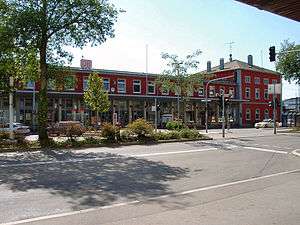
Until its end, the Gäubahn now takes a southerly direction. Near Hattingen, the line meets up with the Black Forest Railway (Schwarzwaldbahn), crosses the volcanic landscape of the Hegau, travels parallel to the Aach river for part of the way, and passes by the Hohentwiel shortly before its terminus in Singen. Near Spaichingen and Hattingen, the line crosses the main European watershed between the Rhine and Danube rivers.
The Gäu Railway is a main line railway, 148.5 kilometers in length. The entire route is electrified and is constructed to be used by the ICE tilting train technology. The line features twin tracks between Stuttgart and Horb and has a total of four tracks between the stations Stuttgart-Österfeld and Stuttgart-Rohr, a 3.5-kilometer-long section. The Gäu Railway and Nagold Valley Railway share tracks between Eutingen und Horb.
The line crosses six districts of the state of Baden-Württemberg, plus the district of Stuttgart, and is part of 5 public transport associations. In the Stuttgart area, and in the district of Böblingen, namely between Stuttgart Hbf and Bondorf, the line is part of the transport-and-tariff association Stuttgart (Verkehrs- und Tarifverbund Stuttgart (VVS)). The station in Ergenzingen is the only station in the district of Tübingen, and is part of the Neckar-Alb-Donau transport association (Verkehrsverbund Neckar-Alb-Donau (NALDO)). Between Eutingen and the industrial station at Neckarhausen, the route traverses the district of Freudenstadt, and its transport association (Verkehrs-Gemeinschaft Landkreis Freudenstadt (VGS)). From Sulz am Neckar to Rottweil-Neufra, the Gäubahn crosses the district of Rottweil, and the transport association (Verkehrsverbund Rottweil (VVR)). Traveling from Aldingen to Tuttlingen, the line then makes its way through the district of Tuttlingen, and its transport association (Verkehrsverbund Tuttlingen (TUTicket)) to Hattigen.
History
History of the name Gäubahn and Overview
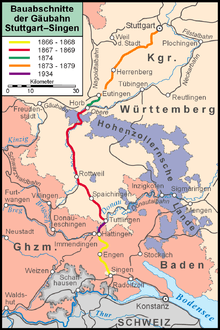
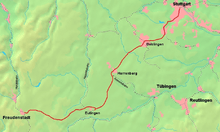
The Gäu line from Stuttgart to Singen was originally cobbled together using a collection of sections of smaller railways, and these only combined in 1934 to become the line as it is today. The term Gäubahn was initially used as the name of the railway running from Stuttgart via Eutingen im Gäu to Freudenstadt, which largely travels through the Gäu, and which was put into service in 1879. Only in the section from Stuttgart to Eutingen do the two identically named lines share tracks. However, the section between Eutingen and Freudenstadt is also called the Gäubahn today.
Before 1934, the name Gäubahn was used for the section Stuttgart-Eutingen, which became an important part of north-south train connections, as well as the name for the section of the Nagold Valley Railway (Nagoldtalbahn) between Eutingen and Horb am Neckar, and for the section of the Upper Neckar Railway (Obere Neckarbahn) between Horb, via Tuttlingen, to Immendingen. Therefore, by 1934 the name Gäubahn was synonymous for the railway sections between Stuttgart and Immendingen, on the border between Württemberg and Baden.
In 1934, the name started to be used in yet another form: When the connection between Tuttlingen and Hattingen was completed, this line then connected the Gäu line to the section of the Black Forest line between Hattingen and Singen, forming a contiguous railway between Stuttgart and the Swiss border near Singen. This entire railway then adopted the term Gäubahn. The section of railway running between Tuttlingen and Immendingen, which had been replaced on the Gäubahn by the new section Tuttlingen-Hattingen, was assigned exclusively to the Danube Valley Railway (Donautalbahn, see Tuttlingen–Inzigkofen railway).
The full length of the Gäubahn traversed the territory of all three of the states in the German southwest in the late 19th century. The section between Hattingen and Singen, which is shared with the Black Forest line, runs through Baden, and was built by the Baden State Railways. Between Tuttlingen and Stuttgart, the line travels through lands in Württemberg, and was constructed by the Royal Württemberg State Railways. In addition, the area claimed by the Province of Hohenzollern reached to the Neckar near Dettingen and Horb, which made the Prussian province an adjacent owner. It was the two former railway companies, however, who built the Gäu line.
Construction of the Singen–Hattingen and Horb–Tuttlingen sections (1866–1869)
The first parts of the line were built at its southern end in Singen, far removed from the eponymous Gäu, by the Baden State Railways. The railway engineer Robert Gerwig, who hailed from Baden, was in the planning stages of a railway, which would cross the Black Forest from Offenburg to Singen, and which would become the Schwarzwaldbahn (Baden). At the time, a connection to Württemberg was not considered. The first part of that line, between Singen and Engen, which was topographically without real challenges, was opened for service on 6 September 1866. The extension of that section to Donaueschingen proved to be technically much more complex, and the construction of the ascending part of the line between Engen and Donaueschingen was not completed until 15 June 1868. The section between Engen and Hattingen is shared with the Gäubahn.
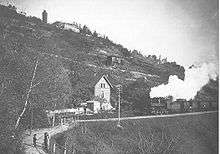

In Württemberg, the Royal Württemberg State Railways had started in the late 1850s to build a line that paralleled the Neckar river, and connected with the Fils Valley Railway in Plochingen. This line, which was dubbed the Upper Neckar Railway, reached Reutlingen in 1859, Rottenburg am Neckar in 1861, and Horb am Neckar in 1866. Extending this route to Rottweil did not present any real technical hurdles, but was politically sensitive, because the areas around Fischingen, Neckarhausen, and Dettingen belonged to the Province of Hohenzollern, which meant that the agreement of Prussia was required to continue construction. The treaty between Prussia and Württemberg of March 1865 solved the issues around the extension of construction through Prussian territory. On 8 October 1867, service was started from Horb in Württemberg to the border town of Talhausen in Hohenzollern. On 23 July 1868, the crews of the Royal Württemberg State Railways reached Rottweil, back in Württemberg.
Württemberg had signed a treaty with Baden as early as 1865, which allowed it to connect to the then-under-construction Schwarzwaldbahn (Baden), and thereby the rail net of the Grand Duchy of Baden. The state therefore constructed not only the Rottweil–Villingen line, but also a line from Rottweil via Spaichingen to Tuttlingen, which opened on 15 July 1869. From Tuttlingen, the Royal Württemberg State Railways extended construction to the border town of Immendingen in Baden, which was done on 26 July 1870, and which meant that the connection to the Black Forest Railway (Baden) had been successfully completed. Starting in 1870, it was then possible to leave the capital in Stuttgart, and to travel by rail via Plochingen, Reutlingen, Horb, Rottweil, and Tuttlingen to Immendingen on Württemberg-owned tracks, and then to connect on to Singen, the Baden-Swiss border near Schaffhausen, and the western edge of Lake Constance (Bodensee). Two trains made the daily trip between Stuttgart and Tuttlingen, and an additional train traveled between Stuttgart and Rottweil only. Connections to Immendingen were initially only possible via Rottweil or Tuttlingen. The primary locomotive on this trip at the time was the Württemberg F class of steam locomotive, which took between 7 and 8 hours to cover the distance.
Construction of the Eutingen–Horb and Horb–Stuttgart sections (1874–1879)
.jpg)
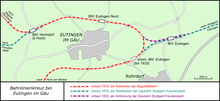
The big disadvantage of this traffic routing was the fact that the tracks would follow the Neckar valley in a lengthy loop, which would make travel times quite a bit longer. However, the Royal Württemberg State Railways did not pursue a more direct connection between Horb and Stuttgart, primarily due to engineering issues to do with the grade between the two points.
The partial section between Eutingen and the connection point to the Obere Neckarbahn in Horb was already completed by 1 June 1874. The aim of this construction was not the connection between Horb, via the Gäu and Böblingen, to Stuttgart, but was done to complete the Nagold Valley Railway from Pforzheim to Horb. This line had been started in 1868, and its connection to Horb meant the establishment of Horb as an important railway node. In 1874, the parts of the full Gäubahn Stuttgart–Singen consisted of the sections Eutingen–Tuttlingen and Hattingen–Singen, while the sections Eutingen–Stuttgart and Tuttlingen–Hattingen were still missing.
On 22 March 1873, the state of Württemberg legislated the creation of a railway between Stuttgart, via Herrenberg and Eutingen, to Freudenstadt, closing the gap between Stuttgart and Eutingen. In the discussions prior to the passage of this law, the term Gäubahn was used for the first time to label the section Stuttgart-Freudenstadt, and the term would later become the name for the entire line between Stuttgart and Singen. In November of the same year, construction on the technically challenging railway began in Stuttgart, led by the Württemberg engineer Georg Morlok. The track routing was quite complex, having to conquer steep grades and incorporating many tunnels. Much of the labor recruited by Morlok came from Italy.
Construction went well: During the winter 1877/78, the line had already reached Herrenberg. On 20 August 1879, after a trial run from Stuttgart to Freudenstadt, the Royal Württemberg State Railways officially opened this section on 2 September 1879, in the presence of chief engineer Georg Morlok, the president of Württemberg Hermann von Mittnacht, the mayor of Stuttgart Gottlob Friedrich von Hack, and many other dignitaries. The construction of this section shortened the distance between Stuttgart via Horb and Tuttlingen to Immendingen by 35 kilometers, and cut the trip time by 1 to 2 hours.
From regional to long-distance railway (1879–1919)
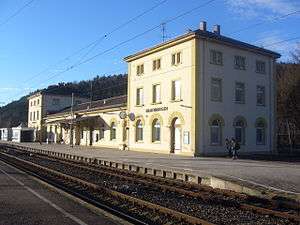
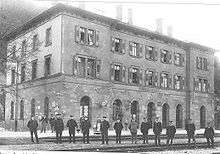
The Gäubahn Stuttgart–Tuttlingen–Immendingen was primarily of regional importance at this time. The terminus of all long-distance travel was Immendingen. However, by the end of the 19th century trip times were becoming quite a bit shorter, to the point where the trip between Tuttlingen and Stuttgart had been cut down to only 3 hours in 1897, 4 to 5 hours less than in the 1870s. Starting in 1900, 3 daily express long-distance trains traversed the line, some of the time from Stuttgart via Immendingen all the way to Zurich. This trip did still require that passengers change trains in Immendingen. Around the turn of the century, the Royal Württemberg State Railways mostly used the steam locomotives of the class Württemberg AD for their express service, which were in turn replaced by the class Württemberg C during World War I. The class Württemberg T 5 was used for regional service. The 9th of April 1917 saw what was probably the most famous passenger on this line, when the leader of the Russian Revolution, Vladimir Lenin, traveled from Zurich via Stuttgart to Petrograd in a special train.
The line also gained in importance in terms of freight service, and in 1897 the Royal Württemberg State Railways already carried 400,000 tonnes of freight on the Gäubahn. Initially, the freight was largely made up of agricultural goods from the rich agrarian area of the Gäu, but soon industrial areas sprang up alongside the railway, which then used the Gäubahn to transport their goods.
The Royal Württemberg State Railways started to lay a second track alongside the originally single-track railway on short sections of the line in the 1880s and 1890s. In 1886, the first section to be made into a twin-track line was the 4.4-kilometer-long piece between Horb am Neckar and Eutingen im Gäu, which was shared between the Gäubahn and Nagoldtalbahn. In 1895, the 8.6-kilometer-long section between Stuttgart Hauptbahnhof and Stuttgart Westbahnhof, which was closed in 1993, received a second track.
Extension and heyday of the Gäubahn (1919–1945)

In the period between World War I and World War II, the transport infrastructure in Germany received numerous improvements. On 22 October 1922, the new main station in Stuttgart (Stuttgart Hauptbahnhof) was officially opened. This removed the chokepoint at the terminus of the Gäubahn and enabled the expansion of the capacity of rail traffic. Once the new station was open for service, the Deutsche Reichsbahn altered the route taken by the Gäubahn in the center of Stuttgart, which avoided the station Stuttgart Nordbahnhof.
In the 1920s, the Free People's State of Württemberg, as Württemberg was known during the Weimar Republic, undertook to expand the single-track lines constructed in the 19th century. The goal was to enable rail traffic from Berlin to Switzerland and Italy to utilize not just the railways in the neighboring territories of Baden and Bavaria, but also to use the Gäubahn, and therefore tracks owned by Württemberg. In addition, the Reichswehr had an interest in a high-capacity rail connection between Berlin and the southwestern border, which, particularly after the return of Alsace-Lorraine to France in 1918, was not as close to the French border as the Rhine Valley Railway from Mannheim to Basel, and would not be as easy to disrupt in the event of war. The occupation of the city of Offenburg by French troops in 1923 reinforced the desire for an effective and efficient Gäubahn.
On the 23 and 24 October 1927, the Free People's State of Württemberg and the Reichsbahn signed a contract, which set out the terms of the expansion of the Gäubahn. Württemberg provided the Reichsbahn with a credit line of 35 million Reichsmark, and the Reichsbahn agreed to expand the section between Stuttgart and Tuttlingen to be twin-tracked, and also to construct a single track connecting line to the station in Hattingen on the Black Forest Railway (Baden).
This construction phase began in 1928. On 15 May 1934 the Reichsbahn opened the 8.2 kilometer-long single-track connection between Tuttlingen and Hattingen. Until construction stopped due to World War II in 1941, the Reichsbahn was also able to complete the expansion of the line to twin tracks from Stuttgart to Tuttlingen, with the exception of a 2.3-kilometer-long piece near Oberndorf am Neckar. With the completion of the single-track connection to Hattingen and the now twin-track Black Forest Railway (Baden), an efficient railway between Stuttgart and Singen had been created. The trip via Immendingen, and the requisite train change at that station, were therefore eliminated. As part of the expansion of the line, the Reichsbahn also expanded the node stations in Rottweil and Horb am Neckar, and replaced the old station buildings in Tuttlingen and Eutingen with new construction.
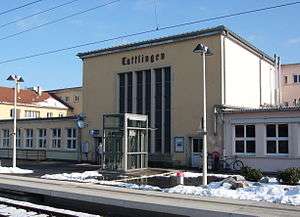
The expansions during the 1920s and 1930s resulted in great improvements in the service schedule on the Gäubahn. Express trains traveled from Berlin via Erfurt, Würzburg, Stuttgart, Zurich, and Milan all the way to Rome. The last peacetime schedule in 1939 showed 3 express trains from Berlin to Italy, even though not all of the trains continued from Milan to Rome. In addition there was express service between Berlin and Lucerne as well as between Stuttgart and Konstanz. Travel time between Stuttgart and Singen was cut to 2 hours and 41 minutes in 1933, and the regional and local service schedules also saw marked improvements.
As was true prior to the railway expansion, and since World War I, the Württemberg class C steam locomotives were used in express service. After the completion of the expansion, it was the Prussian P 10 which assumed the lead on these trains. The Württemberg class C was reassigned to manage the regional and local service traffic. The class Württemberg T 5 was also still seen, but was replaced by 1933 by the DRG Class 24. The Prussian P 8 had already been used since 1920 between Horb and Immendingen. For freight service, the Prussian G 12 as well as the Württemberg K were used. Starting in 1924, the Reichsbahn began to assign the Prussian G 10 to short-distance freight service, and between 1936 and 1938, the DRG Class 86 saw use in the same capacity.
During World War II, passenger service was reduced in favor of the rather more significant freight traffic. The Mauser arms manufacturer in Oberndorf am Neckar was an important user of the line during the war, and Axis partner Italy received coal shipments from Upper Silesia using freight trains on the Gäubahn. The line lost much of its military freight significance in the North-South corridor with the German attack on the Soviet Union, and many of the newer locomotives, especially the Prussian P 10, were relocated by the Reichsbahn to eastern Europe, while passenger trains on the Gäubahn again saw the use of the Württemberg C locomotive.
War damage, dismantlement, and electrification (1945–1990)
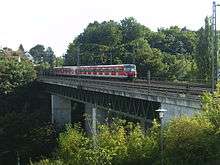
Until February 1945, the Gäubahn did not suffer much damage during World War II, with the exception of aerial bombardment in 1944/45, which caused severe damage to the stations in Herrenberg, Horb am Neckar, Rottweil, Spaichingen, and Tuttlingen. This damage only disrupted traffic in the short term. In February 1945, Allied bomber wings destroyed a bridge in an attack on the town of Oberndorf, which was an important center in the German arms manufacturing industry. Even more significant was the damage caused by German troops in April 1945, when several bridges were blown up between Stuttgart and Böblingen, stopping train traffic altogether shortly before the end of the war. It was not until May 1946 that the railway was opened again for through traffic. Also in April 1945, American and French troops occupied southwestern Germany, which meant that the section of the Gäubahn between Bondorf and Stuttgart fell into the American zone of occupation, while the section between Ergenzingen and Singen was assigned to the French zone.
France insisted on its right to reparations, unlike the United States of America, and in 1946 dismantled the second track between Horb and Tuttlingen, which had only been laid a few years before. Ever since, the Gäubahn is twin-tracked only between Stuttgart and Horb, as well as between Hattingen and Singen. The border between the American and French zones was responsible for the lack of through-traffic between Stuttgart and Singen, which did not resume until 1948. Compared to the heyday of the Gäubahn at the end of the 1930s, the service schedule was severely reduced, and did not reach the same level as before the war until the end of the 1950s. The service to and from Berlin, for which the line had been expanded in the time between the wars, was not resumed by the Deutsche Bundesbahn, and the traffic corridor Berlin–Erfurt–Würzburg–Stuttgart–Zürich had lost its significance due to the separation of East Germany and West Germany.

Starting in the 1950s, the Bundesbahn extended some of the express trains between Zurich and Stuttgart to Hamburg. Also, express service was reinstated between Stuttgart and Italy, largely due to the influx of guest workers from Italy into Baden-Württemberg at the end of the decade. These trains primarily saw the use of the Prussian P 10 and the Prussian P 8. Between 1958 and the middle of the 1970s, diesel locomotives of the class DB Class V 100 and DB Class V 200 replaced the steam locomotives on the Gäubahn, with the DB Class V 200.1 being used for freight service. The Bundesbahn then electrified the section between Stuttgart and Böblingen in 1963, with the goal of reducing travel time in local service trains in the Stuttgart area. The section Böblingen–Horb was converted to electric operation in 1974, and electrification of the rest of the Gäubahn to Singen was completed in 1977, which meant that primarily electric locomotives were used on the railway after 1977. Also in 1977, the Bundesbahn decided to close numerous stations and halts to enable express-like travel, with higher speeds, even in local service trains.

After the section between Böblingen und Stuttgart was electrified in 1963, initially it was locomotives of the DRG class E 17, DB Class 141, DRG Class E 44, and DRB Class ET 55, which saw service. These were then replaced with DRG Class ET 25, DB Class ET 27, and DRG Class ET 65 by 1969. After 1974, and the electrification of the section Böblingen–Horb, the Bundesbahn used the DB Class E 10 for regional service on the northern Gäubahn-section, and used the same locomotive for express service after 1977. For freight service, the Bundesbahn initially relied on the DB Class E 50 and DRG Class E 93, switching to the DB Class 151 in the 1980s, then the DB Class E 40 starting in 1988; since 1993, it has been the DB Class 143 responsible for freight service.
In 1985, the section between Stuttgart and Böblingen was incorporated into the network of the Stuttgart S-Bahn. Since then, the S-Bahn travels from Stuttgart Hbf on the Verbindungsbahn (Stuttgart), which is entirely underground in the center of the city, and which meets up with the Gäubahn at the Stuttgart Österfeld station. The Verbindungsbahn cuts down the trip distance of the S-Bahn by 5.5 kilometers, and puts the University of Stuttgart into the rail network, while regional and long-distance trains still use the old Gäubahn route. The section between Stuttgart-Österfeld and Stuttgart-Rohr, 3.5 kilometers in length, was expanded at high expense into 4 tracks between 1982 and 1983.
New long-distance and local service (since 1990)
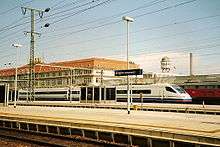
By 1991, the number of express trains on the Gäubahn increased to eight daily trains, with five of those continuing on past Zurich to the cities of Milan, Genoa, and Lecce or Naples. On the other hand, traffic to the north was largely eliminated; for example, just a single express trains traveled on to Nuremberg at the time. The trip between Stuttgart and Singen now took exactly two hours, and was made by locomotives of the DB Class 110 and DB Class 181. Starting in 1993, the Deutsche Bundesbahn, and, from 1994, the privatized Deutsche Bahn AG, attempted to shorten express trip times even further. To achieve this goal, the Gäubahn saw test drives of the Italian Pendolino, as well as the Swedish X 2000. Between 1993 and 1995, two trains of the service type EuroCity replaced some of the traditional express trains on the line. For a short time, TEE-RABe trains of the Swiss Federal Railways were in use, which cut the trip time between Stuttgart and Singen to 1 hour and 50 minutes.
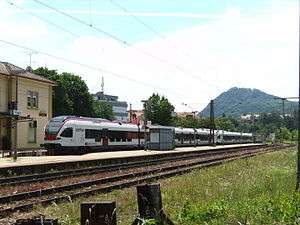
On 1 March 1998, two tilting trains of the type ETR 470, owned by the Swiss firm Cisalpino AG, replaced some express service trains, since German tilting technology trains were not available for service yet. This replacement did not initially result in shorter trip times. In 1999, the DB AG radically altered long-distance traffic on the Gäubahn, and stopped, with one exception, using locomotive-powered trains altogether. For the first time, trains of the type DB AG Class 415 with tilting technology were used on the line, and these trains, together with the Cisalpino, made up the bulk of long-distance trains. This resulted in a trip time of 1 hour and 44 minutes between Stuttgart and Singen. The Cisalpini were responsible for the traffic between Stuttgart and Milan, while the ICE trains carried the load between Stuttgart and Zurich; the through traffic between Stuttgart via Genoa to Naples was eliminated. In 2005, the last locomotive-powered express train, the so-called IC Insubria, was also removed. One year later, in December 2006, the Cisalpino service was stopped, eliminating direct connections to Italy, and making the ICE the only long-distance carrier on the Gäubahn.
Alterations in local service were just as deep as in the case of long-distance travel. On 5 December 1992, the S1 line of the Stuttgart S-Bahn was expanded to Herrenberg, which improved local service between the Gäu and the state capital. In 1994, the Seehas started service on the Gäubahn. This service, which travels between Engen and Singen, was initially managed by the Swiss company Mittelthurgaubahn, due to the lack of suitable DB AG-trains. In 2003, a sizable improvement of local service came about with the establishment of the Ringzug service, which traverses the Gäubahn between Tuttlingen and Rottweil. A commonality between these new local service offerings is the addition of frequently stopping local trains to the express service offerings, which restarted service to the small communities on the Gäubahn. To accommodate this service, DB Station&Service reactivated many closed stations and halts, and built a number of new halts on the line.
Operations
Long-distance traffic
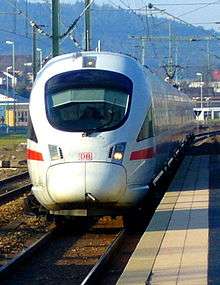
Long-distance service on the Gäubahn in 2009 involves 7 ICE-T trains between Stuttgart and Zurich, running every other hour. A single ICE extends northwards through Stuttgart to Frankfurt am Main. The InterCityExpress service stops at Stuttgart Hbf, Horb am Neckar, Rottweil, Tuttlingen, and Singen; Böblingen, which had been a stop on the long-distance routes for decades, is not served. Starting in December 2006, the 7-car ICE-T of class 411 replaced the 5-car configuration of the class 415, and this service is guaranteed until 2011. At that time, Deutsche Bahn AG will reconsider options in long-distance traffic on the Gäubahn.
Regional traffic
In addition to the ICE trains, Regional-Express (RE) trains traverse the Gäubahn between Stuttgart and Singen, also every other hour. Another set of Regional-Express trains serve the section between Stuttgart and Rottweil, and these trains are separated in Eutingen. Going south, the trains from Stuttgart are split into two halves, with one half traveling the Gäubahn Eutingen–Freudenstadt to Freudenstadt, and the other half continuing on to Rottweil. Going north, these two halves are combined in Eutingen for the trip into Stuttgart. Between the two RE-trains routes (Stuttgart-Singen and Stuttgart-Rottweil), the section between Stuttgart and Rottweil has hourly service. Regional service on the Gäubahn is provided by the Deutsche Bahn AG, which has a long-term contract for this service with the state of Baden-Württemberg until 2016.
In 2004, the DB AG changed the train configuration on the route Stuttgart-Singen from the locomotive-powered trains with Silberling coaches to the new DBAG Class 425 electrical multiple unit trains, which were occasionally replaced by locomotive-powered trains of the class 146, with double-decker coaches, starting in 2006. The use of the class 425 has been greatly reduced on the Stuttgart-Singen route, but those units are still the train of choice on the Stuttgart-Rottweil/Freudenstadt route. Once a day the DB AG still uses modernized Silberling coaches and a locomotive on the trip between Stuttgart and Singen.
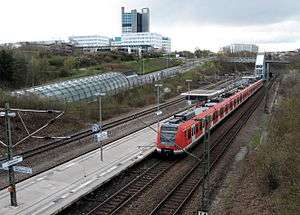
Starting on 16 March 2009, to last until 13 June 2009, the schedules for all traffic was slightly altered. This is due to the fact that since the end of 2008, by order of the German rail authority, tilting technology was not to be used on the Gäubahn. This meant a 10-minute delay for ICE traffic, and disrupted the synchronization of long-distance, regional, and local service schedules. In addition, trains using DB Class 120 locomotives, and Swiss Federal Railway coaches, replaced 4 of the ICE trains from Stuttgart to Zurich.[3]
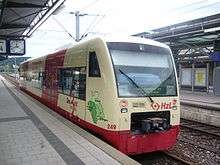
The section between Stuttgart and Herrenberg is integrated into the Stuttgart S-Bahn network. The S 1 service runs from Herrenberg to Stuttgart-Österfeld, where the train leaves the Gäubahn and travels underground via the Verbindungsbahn to Stuttgart Hauptbahnhof. From there, the S 1 service utilizes the Fils Valley Railway as far as Plochingen, before branching off to Kirchheim unter Teck the terminus of the S 1 route. The DBAG Class 423 is used on this route. The S-Bahn is also managed by the Deutsche Bahn AG, and runs every 30 minutes, except at rush hour during the work week, where trains are available every 15 minutes. Between Herrenberg and Eutingen (some of these trains only go to Bondorf), DB AG also runs RegionalBahn trains every hour under the week, whose schedules are synchronized with the S-Bahn trains. In addition, during the work week a train owned by the Albtal-Verkehrs-Gesellschaft travels between Freudenstadt, Eutingen, and Herrenberg, where it connects to the S-Bahn.
On the section Rottweil-Tuttlingen, the Ringzug of the Hohenzollerische Landesbahn provides local service. The Stadler Regio-Shuttle RS1 travel on the Gäubahn at least hourly under the week, and every other hour on weekends. Between Engen and Singen service is provided every 30 minutes by the Seehas of the type Stadler FLIRT, which is today managed by SBB GmbH, a subsidiary of the Swiss Federal Railway. Every other hour, the RE-trains of the DB AG, which travel on the Black Forest Railway (Baden) between Karlsruhe and Konstanz, provide additional service between Engen and Singen, using double-decker coaches powered by class 146 locomotives.
Freight traffic
The Gäubahn is again becoming a significant railway in terms of international freight traffic, particularly as an alternative to the heavily traveled Rhine Valley Railway, primarily as a transit route. With the exception of the connecting line to the industrial area of Böblingen-Hulb, no freight is processed for shipment directly on the line. Railion trains travel primarily from the large shunting station near Kornwestheim to St. Margrethen in Switzerland, and go around Stuttgart Hbf. This was accomplished until the 1970s via the Pragtunnel, Bahnhof Stuttgart-West, and a connection loop, but has been handled since the opening of the Stuttgart S-Bahn by running freight trains via the Rankbach Railway (Rankbachbahn) from Kornwestheim via Leonberg to Böblingen and the Gäubahn. Railion mostly utilizes the class 185 locomotives.
Operational challenges
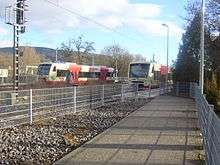
Notwithstanding the sizable reductions in trip times in the last decades, the Gäubahn is still a comparatively slow line, largely due to the single-track section between Horb and Hattingen. Particularly in the section between Tuttlingen and Rottweil, the single track is used by ICE, Regional-Express, freight traffic, and the Ringzug, which leads to numerous times where Ringzug trains have to stop at the stations in Wurmlingen, Spaichingen, and Aldingen to await a train traveling in the opposite direction. Even ICE trains have to make a scheduled stop in the industrial station in Epfendorf to await oncoming traffic. In Stuttgart, the scheduled ICE service misses the important ICE connections to Berlin and Dortmund by a few minutes, which makes these ICE connections less attractive. The Gäubahn is also challenged by the modernized Bundesautobahn 81.
Plans for the future
Reestablishment of twin-track configuration
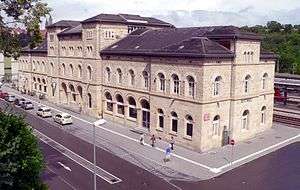
The reestablishment of the Gäubahn in a twin-track configuration has been a topic of discussion in every decade since its dismantlement. Today there are different plans in existence, which would expand the section between Horb and Hattingen at least partially. This expansion is part of both the federal traffic plan (Bundesverkehrswegeplan) as well as the general traffic plan (Generalverkehrsplan) of the state of Baden-Württemberg. In 2006 the Federal Transport Ministry published a comparative study, where benefits of the electrification of the Southern Railway, the electrification of the Allgäu Railway (Bavaria), and the expansion of the Gäubahn were studied. The latter finished this comparison clearly in third place, compared to the other two projects, which were given higher ratings in positive economic impact.
The Interior Ministry of Baden-Württemberg underwrote a new study, which was to find new suggestions for an economically feasible plan for Gäubahn-expansion. This study of March 2007 does not envision an expansion of the complete section between Tuttlingen and Horb, but suggests twin-track expansion work for the pieces Horb-Neckarhausen, Rottweil–Spaichingen, and Rietheim–Wurmlingen, and to leave the rest of the section as is. The study suggested a cost of 135 million Euros for the project, and assigned it an economic impact rating of 1.3, compared to the 0.6 rating of the earlier comparative study. This expansion would reduce the trip time by 9 minutes, and would result in the synchronization of the ICE connections to Berlin and Dortmund. In addition, the trip times of the Ringzug between Rottweil and Tuttlingen would be reduced from 41 to 32 minutes, without eliminating any of the present stops. The municipalities on the Gäubahn, collectively associated in the Interessenverband Gäu-Neckar-Bodensee-Bahn, declared their willingness in March 2008 to provide financing of 360,000 Euros in advance for the planning phase of this expansion to twin tracks. The study allocated a total of 10 million Euros for general activities to increase the travel speed, and another 10 million Euros for the twin-track expansion in the section between Horb and Neckarhausen, with a planned start to construction in 2012 or 2013. The timely expansion of the rest of the sections seems to be much less realistic in light of the expense of the Stuttgart 21 project.
Stuttgart 21
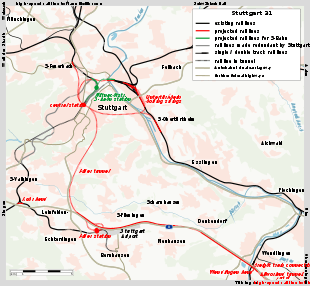
The project Stuttgart 21 aims to eliminate the tunnel-rich and steep section of the Gäu line in the center of Stuttgart. The plans see trains on the line taking a new route, on new tracks, from Stuttgart Hbf in the direction of Stuttgart Airport, where they would meet the planned Wendlingen–Ulm high-speed railway. From the airport, the Gäu line trains going in the direction of Böblingen would take the existing S-Bahn tracks to Stuttgart-Rohr, and would connect to the existing Gäu line via a new Rohr loop. This new route would extend the distance to Böblingen by 4.4 kilometers and would lengthen the trip for a Regional-Express train by 5 minutes.
For regional and long-distance trains from the direction of Singen, this new route would shorten the trip to the airport, and would no longer require a change of trains. However, at this time the exact nature of how Gäu line trains would stop at the airport is undecided. The use of the new Filder station would require the construction of a connecting line underneath the exhibition center at a cost of €100 million. The present plans call for the use of the existing S-Bahn station at the airport, but the Transport Ministry has so far shown no willingness to permit the required lowering of the tracks.
One additional use of the present Gäu line tracks is their ability to serve as an alternate route in case of the blockage of the S-Bahn tunnel between Stuttgart-Rohr and Stuttgart Hbf. This capability would no longer exist if this section was eliminated.
Local operations
The district of Rottweil explored the possibility between June and October 2008 of expanding Ringzug operations from Rottweil to Horb on the Gäubahn. As a result of an expansion, the Regional-Express halts in Sulz am Neckar and Oberndorf am Neckar would be eliminated. These plans failed when the towns of Sulz and Oberndorf expressed their opposition. In addition, as a result of the reactivation of the Rankbach Railway for the Stuttgart S-Bahn, the districts of Calw and Böblingen underwrote a study in July 2008 to explore the expansion of the S 1 line to Eutingen and Nagold.
See also
- History of the railway in Württemberg
References
Footnotes
- Eisenbahnatlas Deutschland [German railway atlas]. Schweers + Wall. 2009. pp. 94, 103, 111, 168. ISBN 978-3-89494-139-0.
- "Stuttgart Region in Europe". Region Stuttgart. Retrieved 16 March 2011.
- "DB passt Fahrpläne für Fernverkehrslinie Stuttgart-Zürich an – Längere Fahrzeit auf der Gäubahn jetzt in Auskunfts- und Buchungssysteme eingearbeitet" [DB fits timetables for Stuttgart-Zurich long-distance service - Longer journey time on Gäubahn now incorporated into information and booking systems]. Bahnonline.ch. 18 March 2009. Retrieved 24 March 2009.
Sources
- Fladt-Stähle, Georg (2005). "Stuttgarter Balkon. 125 Jahre Gäubahn". LOK MAGAZIN (281): 84–91. ISSN 0458-1822.
- Leute, Richard (1983). "Die Geschichte der Eisenbahn im Raum Tuttlingen". Tuttlinger Heimatblätter (46): 46–62.
- Scharf, Hans-Wolfgang; Wollny, Burkhard (1992). Die Gäubahn von Stuttgart nach Singen. Freiburg im Breisgau: EK-Verlag. ISBN 3-88255-701-X.
- von Meißner, Frank (2004). "Magistrale im Verkehrsschatten: Die Gäubahn Stuttgart–Singen". Eisenbahn-Kurier (9): 36–41. ISSN 0170-5288.
- von Meissner, Frank (2005). "Was wird aus dem Gäubahn-Fernverkehr? Die letzten Tage des IC Insubria". Eisenbahn-Kurier (11): 48–50. ISSN 0170-5288.
- Wedler, Jürgen; Böttcher, Karl-Heinz (1985). Der Tunnel. Verbindungsbahn der S-Bahn Stuttgart. Dokumentation ihrer Entstehung. Kohlhammer, Stuttgart: BD Stuttgart. ISBN 3-925565-01-9.
- Gaßebner, Jürgen; Jacobson, Claus-Jürgen (1999). Bahnanlagen aus der Luft. Baden-Württemberg. Stuttgart: Transpress-Verlag. ISBN 3-613-71098-6.